Yanfei Chen
In Prospect and Retrospect: Reflective Memory Management for Long-term Personalized Dialogue Agents
Mar 11, 2025Abstract:Large Language Models (LLMs) have made significant progress in open-ended dialogue, yet their inability to retain and retrieve relevant information from long-term interactions limits their effectiveness in applications requiring sustained personalization. External memory mechanisms have been proposed to address this limitation, enabling LLMs to maintain conversational continuity. However, existing approaches struggle with two key challenges. First, rigid memory granularity fails to capture the natural semantic structure of conversations, leading to fragmented and incomplete representations. Second, fixed retrieval mechanisms cannot adapt to diverse dialogue contexts and user interaction patterns. In this work, we propose Reflective Memory Management (RMM), a novel mechanism for long-term dialogue agents, integrating forward- and backward-looking reflections: (1) Prospective Reflection, which dynamically summarizes interactions across granularities-utterances, turns, and sessions-into a personalized memory bank for effective future retrieval, and (2) Retrospective Reflection, which iteratively refines the retrieval in an online reinforcement learning (RL) manner based on LLMs' cited evidence. Experiments show that RMM demonstrates consistent improvement across various metrics and benchmarks. For example, RMM shows more than 10% accuracy improvement over the baseline without memory management on the LongMemEval dataset.
Magnet: Multi-turn Tool-use Data Synthesis and Distillation via Graph Translation
Mar 10, 2025Abstract:Large language models (LLMs) have exhibited the ability to effectively utilize external tools to address user queries. However, their performance may be limited in complex, multi-turn interactions involving users and multiple tools. To address this, we propose Magnet, a principled framework for synthesizing high-quality training trajectories to enhance the function calling capability of large language model agents in multi-turn conversations with humans. The framework is based on automatic and iterative translations from a function signature path to a sequence of queries and executable function calls. We model the complicated function interactions in multi-turn cases with graph and design novel node operations to build reliable signature paths. Motivated by context distillation, when guiding the generation of positive and negative trajectories using a teacher model, we provide reference function call sequences as positive hints in context and contrastive, incorrect function calls as negative hints. Experiments show that training with the positive trajectories with supervised fine-tuning and preference optimization against negative trajectories, our 14B model, Magnet-14B-mDPO, obtains 68.01 on BFCL-v3 and 73.30 on ToolQuery, surpassing the performance of the teacher model Gemini-1.5-pro-002 by a large margin in function calling.
PlanGEN: A Multi-Agent Framework for Generating Planning and Reasoning Trajectories for Complex Problem Solving
Feb 22, 2025Abstract:Recent agent frameworks and inference-time algorithms often struggle with complex planning problems due to limitations in verifying generated plans or reasoning and varying complexity of instances within a single task. Many existing methods for these tasks either perform task-level verification without considering constraints or apply inference-time algorithms without adapting to instance-level complexity. To address these limitations, we propose PlanGEN, a model-agnostic and easily scalable agent framework with three key components: constraint, verification, and selection agents. Specifically, our approach proposes constraint-guided iterative verification to enhance performance of inference-time algorithms--Best of N, Tree-of-Thought, and REBASE. In PlanGEN framework, the selection agent optimizes algorithm choice based on instance complexity, ensuring better adaptability to complex planning problems. Experimental results demonstrate significant improvements over the strongest baseline across multiple benchmarks, achieving state-of-the-art results on NATURAL PLAN ($\sim$8%$\uparrow$), OlympiadBench ($\sim$4%$\uparrow$), DocFinQA ($\sim$7%$\uparrow$), and GPQA ($\sim$1%$\uparrow$). Our key finding highlights that constraint-guided iterative verification improves inference-time algorithms, and adaptive selection further boosts performance on complex planning and reasoning problems.
TableRAG: Million-Token Table Understanding with Language Models
Oct 07, 2024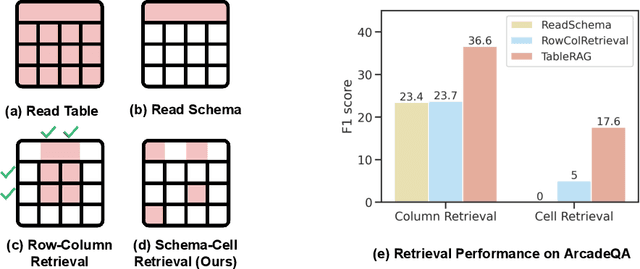
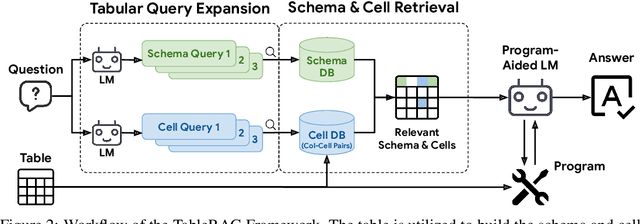

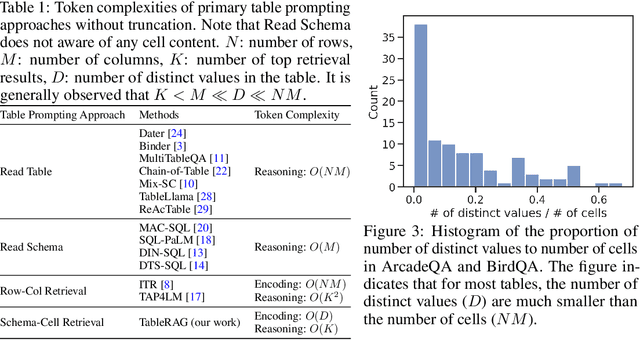
Abstract:Recent advancements in language models (LMs) have notably enhanced their ability to reason with tabular data, primarily through program-aided mechanisms that manipulate and analyze tables. However, these methods often require the entire table as input, leading to scalability challenges due to the positional bias or context length constraints. In response to these challenges, we introduce TableRAG, a Retrieval-Augmented Generation (RAG) framework specifically designed for LM-based table understanding. TableRAG leverages query expansion combined with schema and cell retrieval to pinpoint crucial information before providing it to the LMs. This enables more efficient data encoding and precise retrieval, significantly reducing prompt lengths and mitigating information loss. We have developed two new million-token benchmarks from the Arcade and BIRD-SQL datasets to thoroughly evaluate TableRAG's effectiveness at scale. Our results demonstrate that TableRAG's retrieval design achieves the highest retrieval quality, leading to the new state-of-the-art performance on large-scale table understanding.
Re-Invoke: Tool Invocation Rewriting for Zero-Shot Tool Retrieval
Aug 03, 2024



Abstract:Recent advances in large language models (LLMs) have enabled autonomous agents with complex reasoning and task-fulfillment capabilities using a wide range of tools. However, effectively identifying the most relevant tools for a given task becomes a key bottleneck as the toolset size grows, hindering reliable tool utilization. To address this, we introduce Re-Invoke, an unsupervised tool retrieval method designed to scale effectively to large toolsets without training. Specifically, we first generate a diverse set of synthetic queries that comprehensively cover different aspects of the query space associated with each tool document during the tool indexing phase. Second, we leverage LLM's query understanding capabilities to extract key tool-related context and underlying intents from user queries during the inference phase. Finally, we employ a novel multi-view similarity ranking strategy based on intents to pinpoint the most relevant tools for each query. Our evaluation demonstrates that Re-Invoke significantly outperforms state-of-the-art alternatives in both single-tool and multi-tool scenarios, all within a fully unsupervised setting. Notably, on the ToolE datasets, we achieve a 20% relative improvement in nDCG@5 for single-tool retrieval and a 39% improvement for multi-tool retrieval.
Chain of Agents: Large Language Models Collaborating on Long-Context Tasks
Jun 04, 2024



Abstract:Addressing the challenge of effectively processing long contexts has become a critical issue for Large Language Models (LLMs). Two common strategies have emerged: 1) reducing the input length, such as retrieving relevant chunks by Retrieval-Augmented Generation (RAG), and 2) expanding the context window limit of LLMs. However, both strategies have drawbacks: input reduction has no guarantee of covering the part with needed information, while window extension struggles with focusing on the pertinent information for solving the task. To mitigate these limitations, we propose Chain-of-Agents (CoA), a novel framework that harnesses multi-agent collaboration through natural language to enable information aggregation and context reasoning across various LLMs over long-context tasks. CoA consists of multiple worker agents who sequentially communicate to handle different segmented portions of the text, followed by a manager agent who synthesizes these contributions into a coherent final output. CoA processes the entire input by interleaving reading and reasoning, and it mitigates long context focus issues by assigning each agent a short context. We perform comprehensive evaluation of CoA on a wide range of long-context tasks in question answering, summarization, and code completion, demonstrating significant improvements by up to 10% over strong baselines of RAG, Full-Context, and multi-agent LLMs.
Search-Adaptor: Text Embedding Customization for Information Retrieval
Oct 12, 2023Abstract:Text embeddings extracted by pre-trained Large Language Models (LLMs) have significant potential to improve information retrieval and search. Beyond the zero-shot setup in which they are being conventionally used, being able to take advantage of the information from the relevant query-corpus paired data has the power to further boost the LLM capabilities. In this paper, we propose a novel method, Search-Adaptor, for customizing LLMs for information retrieval in an efficient and robust way. Search-Adaptor modifies the original text embedding generated by pre-trained LLMs, and can be integrated with any LLM, including those only available via APIs. On multiple real-world English and multilingual retrieval datasets, we show consistent and significant performance benefits for Search-Adaptor -- e.g., more than 5.2% improvements over the Google Embedding APIs in nDCG@10 averaged over 13 BEIR datasets.
Deep Learning System to Screen Coronavirus Disease 2019 Pneumonia
Feb 21, 2020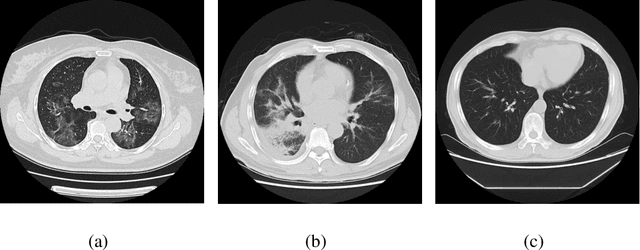
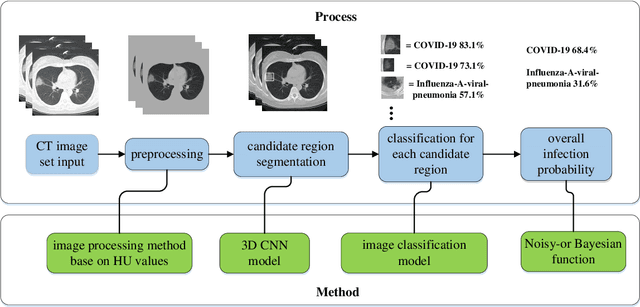


Abstract:We found that the real time reverse transcription-polymerase chain reaction (RT-PCR) detection of viral RNA from sputum or nasopharyngeal swab has a relatively low positive rate in the early stage to determine COVID-19 (named by the World Health Organization). The manifestations of computed tomography (CT) imaging of COVID-19 had their own characteristics, which are different from other types of viral pneumonia, such as Influenza-A viral pneumonia. Therefore, clinical doctors call for another early diagnostic criteria for this new type of pneumonia as soon as possible.This study aimed to establish an early screening model to distinguish COVID-19 pneumonia from Influenza-A viral pneumonia and healthy cases with pulmonary CT images using deep learning techniques. The candidate infection regions were first segmented out using a 3-dimensional deep learning model from pulmonary CT image set. These separated images were then categorized into COVID-19, Influenza-A viral pneumonia and irrelevant to infection groups, together with the corresponding confidence scores using a location-attention classification model. Finally the infection type and total confidence score of this CT case were calculated with Noisy-or Bayesian function.The experiments result of benchmark dataset showed that the overall accuracy was 86.7 % from the perspective of CT cases as a whole.The deep learning models established in this study were effective for the early screening of COVID-19 patients and demonstrated to be a promising supplementary diagnostic method for frontline clinical doctors.
 Add to Chrome
Add to Chrome Add to Firefox
Add to Firefox Add to Edge
Add to Edge